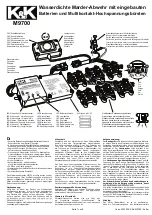
Functions
2.8 Earth Fault Protection in Earthed Systems (optional)
SIPROTEC, 7SD5, Manual
C53000-G1176-C169-5, Release date 02.2011
217
2.8
Earth Fault Protection in Earthed Systems (optional)
The 7SD5 line protection features protection functions for high-resistance earth faults in earthed systems. The
following options are available, depending on the version ordered:
Three overcurrent stages with definite time tripping characteristic (definite time),
– One overcurrent stage with inverse time characteristic (IDMT) or
– One zero-sequence voltage stage with inverse time characteristic
– One zero-sequence power stage with inverse time characteristic
The stages may be configured independently of each other and combined according to the user's require-
ments. If the fourth current, voltage or power dependent stage is not required, it may be employed as a fourth
definite time stage.
Each stage may be set to non directional or directional — forward or reverse. For each stage it can be deter-
mined if it should cooperate with the teleprotection function. If the protection is applied in the proximity of trans-
formers, an inrush restraint can be activated. Furthermore, blocking by external criteria is possible via binary
inputs (e.g. for reverse interlocking or external automatic reclosure). During energisation of the protected feeder
onto a dead fault it is also possible to release any one stage or several stages for non-delayed tripping. Stages
that are not required, are disabled.
In the line protection 7SD5, the distance protection function (order option) can be supplemented by the earth
fault protection function. In the case of short-circuits with high fault resistances, the fault detection of the dis-
tance protection often does not pick up because the measured impedance is outside the fault detection char-
acteristic of the distance protection. High fault resistances can be found, for instance, in overhead lines without
earth wire or in sandy soil.
2.8.1
Functional Description
Measured Quantities
The zero-sequence current is used as measured variable. According to its definition equation it is obtained from
the sum of the three phase currents, i.e. 3·
I
0
=
I
L1
+
I
L2
+
I
L3
. Depending on the version ordered, and the con-
figured application for the fourth current input
I
4
of the device, the zero-sequence current can be measured or
calculated.
If input
I
4
is connected in the starpoint of the set of current transformers or to a separate earth current trans-
former on the protected feeder, the earth current is directly available as a measured value.
If the device is fitted with the highly sensitive current input for
I
4
, this current
I
4
is used when allocated and takes
the set factor
I4/Iph CT
into consideration (address
221
, see section 2.1.2.1). As the linear range of this
measuring input is restricted considerably in the high range, this current is only evaluated up to an amplitude
of approx. 1.6 A. In the event of larger currents, the device automatically switches over to the evaluation of the
zero-sequence current derived from the phase currents. Naturally, all three phase currents obtained from a set
of three star-connected current transformers must be available and connected to the device. The processing
of the earth current is then also possible if very small as well as large earth fault currents occur.
If the fourth current input
I
4
is otherwise utilized, e.g. for a transformer starpoint current or for the earth current
of a parallel line, the device calculates the zero-sequence current from the phase currents. Naturally in this case
also all three phase currents derived from a set of three star connected current transformers must be available
and connected to the device.
















































